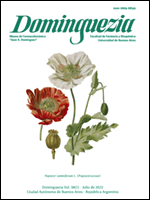Biofungicidal capacity on Beauveria bassiana (Bals-Criv.) Vuill. and phytochemical characterization of native medicinal plants of the province of Misiones
Keywords:
muscardine, Bombyx mori , Baccharis crispa , Mikania cordifolia, Pityrogramma calomelanos, Polygonum punctatumAbstract
The objective of this work was to find an alternative to the chemical fungicides that are currently used in the control of the fungus Beauveria bassiana (Bals-Criv.) Vuill, causative agent of white muscardine in Bombyx mori L. In this study we examined 6 native medicinal plants to determine its antifungal activity and phytochemical composition. The antifungal activity of the extracts (2 to 8 %) was evaluated by means of the IB (biological index) determined on the potential germination, vegetative growth and the production of conidia. The extracts of Baccharis crispa 4 and 6 % (37.2 and 36.4); Mikania cordifolia 6 % (36.24); Pityrogramma calomelanos 4 % (40.4); and Polygonum punctatum 6 and 8 % (33.1 and 35.5) were active with values €‹â€‹within the toxicity range (0-41) while Schinus molle and Ocimum tenuiflorum, they did not exhibit antifungal potential. The phyto chemical characterization between the active extracts determined that the phenolic content varies between 62.5 to 103.7 mg GAE/g extract, while for tannins it was 19.7 to 72.5 mg GAE/g extract, and total flavonoids of 11.6 to 33.7 mg Qe/g extract. The extracts of B. crispa, M. cordifolia, P. calomelanos and P. punctatum were effective to control Beauveria bassiana in vitro.



